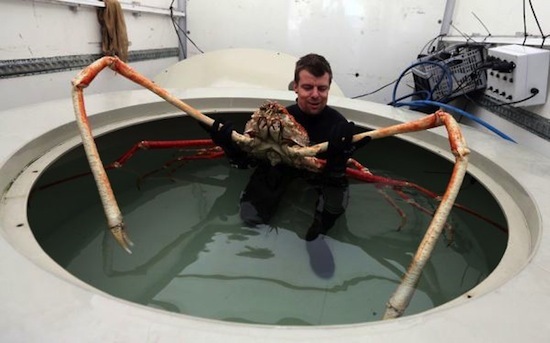The Japanese spider crab is a species of marine crab and is the biggest one that lives in the waters around Japan. It has the largest known leg-span of any arthropod around 3.7 meters. The Japanese name for this species is taka-ashi-gani, literally translating to “tall legs crab”. Japanese spider crabs get their name from their resemblance to a spider. It has a rounded body covered with stubby projections and long slim legs. Maximum size of up to 12 feet (3.7 m) across. Japanese spider crabs will grow to about 15 inches (38 cm) wide and the animal can weigh up to 44 lbs. Japanese spider crabs live on the seafloor along Japan's Pacific coast. They are found primarily on the sandy and rocky continental shelf and slope. When adult crabs are ready to spawn, they migrate to shallower waters, about 160 feet (50 meters) deep. These slow-moving crabs spend much of their time walking on the seafloor searching for food — they do not swim. Instead of hunting, these scavengers look for dead and decaying matter along the seafloor. Their diet includes dead or decaying fish, invertebrates, and algae. While most of what they eat is dead, they are known to sometimes pry open mollusks, tear and eat live algae, and catch small marine invertebrates. The large size and armored exoskeleton of Japanese spider crabs discourages most ocean predators, but a hungry octopus or a trawling net may snag and tear off one of the crab’s long, delicate limbs. Japanese spider crabs are most vulnerable to predators right after molting — after they shed their exoskeleton and before the new shell hardens. Giant spider crabs also use camouflage — their bumpy shell helps them blend into the rocky ocean floor. Juvenile spider crabs will also decorate their shells with sponges or kelp to better camouflage themselves from predators. Full-grown Japanese spider crabs rely more on their size and their claws to ward off predators. Humans eat these crabs as a delicacy during crab-fishing season. But, since adult crabs live deep in the water, they are challenging for humans to catch. Efforts are being made to protect these animals and their populations from the danger of overfishing.
